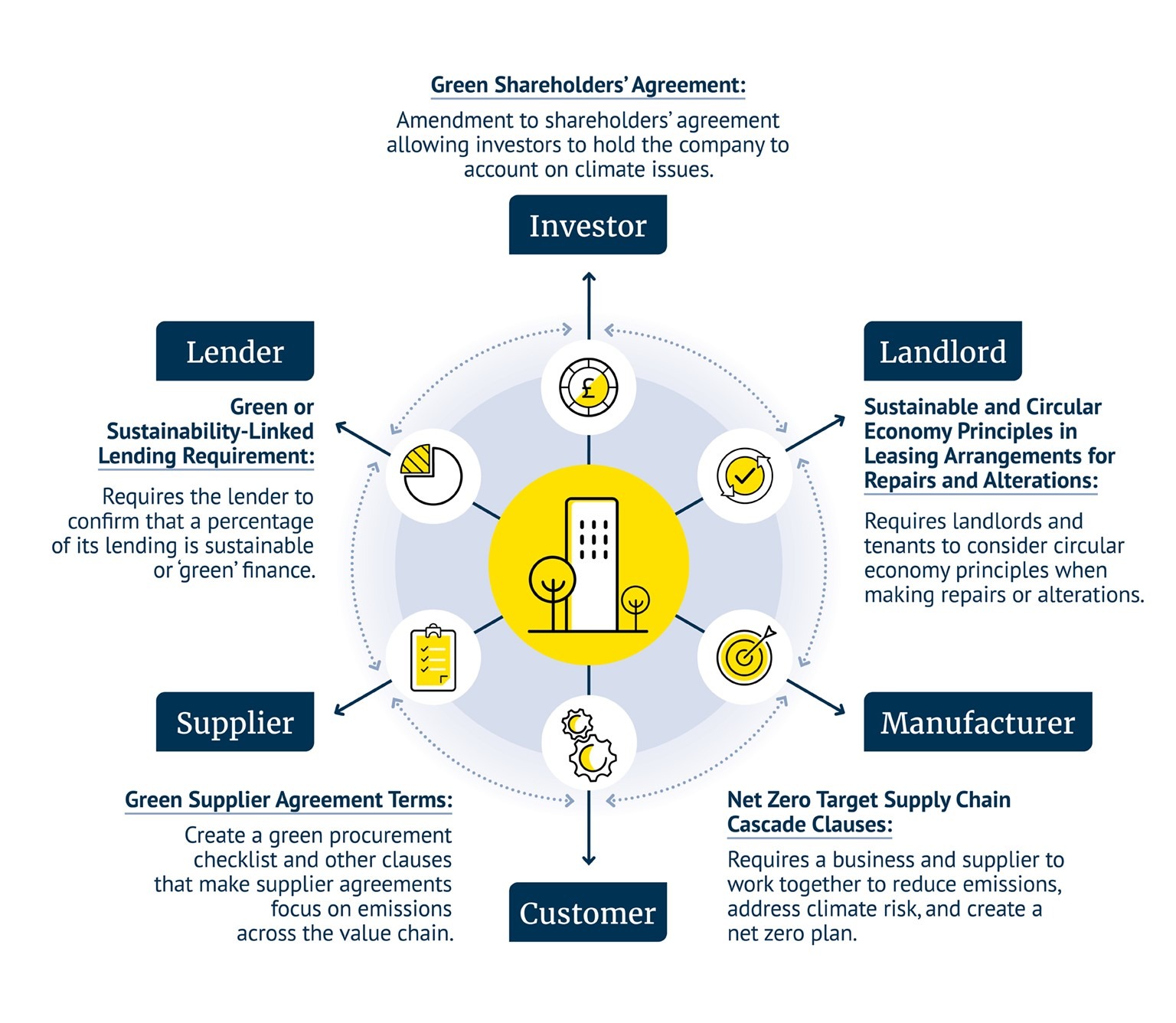
Climate Contracting Explainer: Integrating climate-conscious clauses into your supply chain
What is climate contracting?
Climate contracting involves inserting clauses into your organisation’s contracts that help deliver its net zero transition goals. This can take many forms, including addressing issues such as adaptation, but this explainer will focus on clauses that lead to the reporting and reduction of carbon.
How contracting delivers your climate goals
Most large organisations now have net zero emission targets, and all businesses use contracts with suppliers. Climate contracting combines the two to deliver net zero ambition in a way that is aligned with your operations, and this is particularly important in any procurement exercise; what is in the contract is what gets done.
Contracts provide certainty as to business terms, expectations and obligations, and consequences if something goes wrong. Yet, when it comes to net zero emission targets, many businesses do not employ the same certainty requirements and they do not put the obligations and actions needed for success in climate into their contracts.
Climate change is the new landscape for all business transactions and this will be increasingly felt the more physical climate effects, regulatory impacts and transition risks accelerate. Failure to get climate principles into contracts means missing out on business opportunities and valuable early alignment with incoming climate-related regulations. Once a contract is signed, the terms are locked until the contract expires or a termination clause is triggered. Contracts need to be future-proofed now on climate issues to deliver on the company’s emission reduction targets, as the pace of climate change impacts runs faster than the expiration dates of most contracts.
Contracts support and drive climate goals demonstrably because they are:
- Fast: contracts can implement change quickly.
- Familiar: the same mechanisms and tools used to ensure quality services, pricing, etc can all be repurposed to achieve climate targets.
- Frameworks: you can embed consistent climate data reporting requirements.
- Flexible: you can tailor the requirements of your contract to suit your specific sector.
- Enforceable: using all the same mechanisms for missed obligations.
There are many climate intervention points in the contract lifecycle which can build on each other to reinforce the impact.
Do these clauses exist already?
Yes, The Chancery Lane Project have published over 100 example climate clauses for contracts and other tools. The clauses were created through a global collaborative pro bono effort and were drafted and peer-reviewed by expert lawyers. All these resources are free to use and available on the Project’s website.
Your in-house legal team, or law firms who advise you, will be able to adapt these clauses to meet your organisation’s requirements.
How is this linked to Scope 3 emissions?
Scope 3 emissions often make up a significant portion of a company's overall carbon footprint, and they can arise from activities such as purchased goods and services, transportation, and use of products. Integrating climate clauses into contracts with suppliers can be a valuable strategy for addressing and reducing Scope 3 emissions, which represent indirect emissions that occur in a company's value chain. It will foster transparency throughout the value chain, and help with stakeholder engagement and collaboration in reaching emission reduction targets. The company can therefore exert positive influence throughout its supply chain as it will benefit systems more largely, by accelerating transformation beyond the company’s supply chain.
How is this linked to transition planning?
Including climate-related clauses in procurement contracts can be a strategic and impactful approach for companies as they navigate the challenges and opportunities associated with climate change. Boards, including non-executive directors, should be actively involved in overseeing and guiding these initiatives to ensure they align with the company's overall transition plan to net zero emissions and contribute to long-term sustainability and resilience.

The Chapter Zero Transition Planning Toolkit
Try Chapter Zero’s Transition Planning Toolkit. It is designed to support you as a NED and your board in overseeing the development of a credible transition and delivery against that plan.
Access the ToolkitMy organisation is still working on its transition plan, does this matter?
No, there are a range of clauses from low ambition to high ambition that you can use straight away. The key is to ensure that you maintain contractual flexibility today so you can pivot to meet your transition plan when it is adopted.
Are other organisations using climate clauses?
Yes, The Chancery Lane Project has produced case studies highlighting how other organisations are already using the clauses to achieve their goals.
The graphic below shows how climate clauses can be integrated throughout the whole business’ supply chain.

What can non-executive directors do about it?
As a non-executive director, you can play an important role in advocating for the integration of climate-conscious clauses in contracts and your organisation’s supply chain.
- Engage: Ask your organisation’s General Counsel, CLO or Company Secretary how they are using contracting to meet climate goals. Talk to other non-executive directors on the board: do they understand the benefits of climate contracting and the risks of ignoring it?
- Instruct: If you don’t have an in-house legal team, ask the person in your organisation who instructs external law firms to ask them to adopt climate contracting for the work they do for your organisation.
- Enquire: when making decisions relating to major contracts or transactions, consider how climate clauses may play a role.
Climate clauses are an important tool for any organisation looking to demonstrate their commitment to addressing climate change. By setting clear targets, reporting on their progress, and creating accountability mechanisms, companies can build trust with stakeholders and drive meaningful action on climate and sustainability more generally.





